Best Strategies To Day Trade In Forex



Editorial Note: While we adhere to strict Editorial Integrity, this post may contain references to products from our partners. Here's an explanation for How We Make Money. None of the data and information on this webpage constitutes investment advice according to our Disclaimer.
Best Forex day trading strategies:
Forex day trading offers a real chance to profit from the fast-moving foreign exchange market. But jumping in without a plan is like diving into deep waters without knowing how to swim — it’s risky and can lead to losses. To help traders make smarter decisions, we’ve put together a list of seven day trading strategies designed to keep things simple and effective. You’ll learn the basics of Forex trading, how to spot good opportunities, set realistic targets, and protect yourself with smart stop-loss levels. Whether you’re just starting out or looking to refine your approach as a day trader, this guide breaks down the strategies in a way that’s practical and easy to apply.
Best Forex day trading strategies
Forex, short for foreign exchange, refers to the global market where currencies are bought and sold. Day trading, meanwhile, involves executing and closing trades within a single trading day. Combining the two, Forex day trading is a strategy where traders open and close positions in currency pairs within the same day. This approach to short-term trading is particularly favored by retail traders seeking quick market opportunities.
Moving average strategy
The Moving Average (MA) strategy is a popular trading strategy used in the Forex market. It involves using moving averages (MA) to identify trends and make trading decisions. The strategy works by calculating the average price of a currency pair over a specific period, such as 20, 50, or 200 days. Traders then use this moving average line to identify the market trend. If the price is above the moving average line, it's considered a bullish trend, and if it's below, it's a bearish trend. Another way to use the moving averages is by looking at the crossover of shorter-duration and longer-duration moving averages. When the shorter duration moving average crosses above the longer duration moving average, a buy signal is generated, and vice versa.
One of the main benefits of the Moving Average strategy is its simplicity. It's a straightforward trading strategy that's easy to understand and implement. Additionally, the strategy can be used with other technical indicators, such as the Relative Strength Index (RSI) or the Moving Average Convergence Divergence (MACD) indicator, to increase its effectiveness.
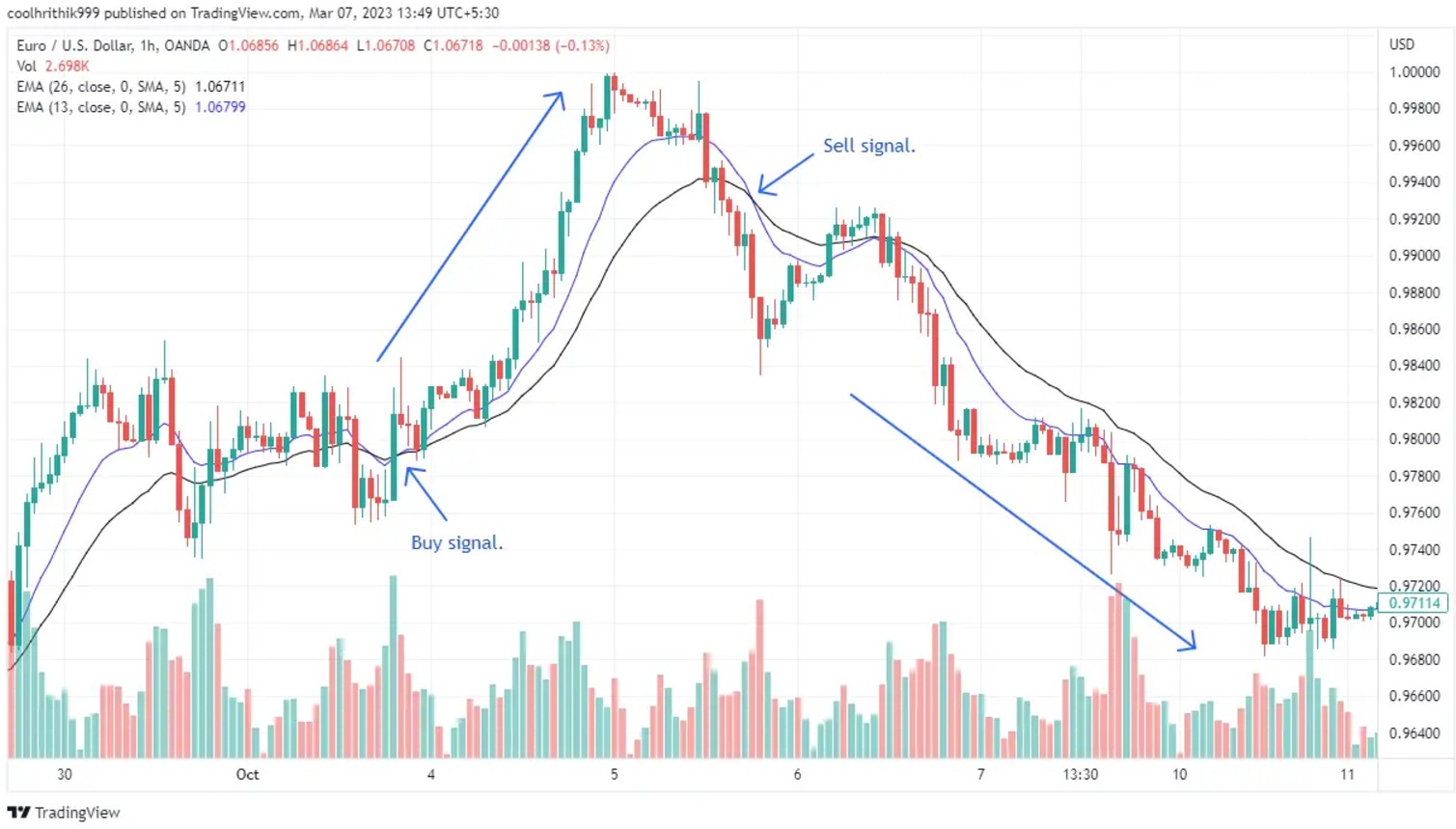
50 pips a day Forex
The 50 pips a day Forex trading strategy is a famous approach among traders looking to make consistent profits by identifying high-probability trades. The strategy involves using a combination of technical indicators, including the Moving Average and Relative Strength Index (RSI), to confirm the trend and identify entry and exit points. This strategy can be applied to any currency pair and generally uses a 15-minute chart for entry and exit signals.
To use this strategy effectively, traders should first look for currency pairs that are trending in a specific direction and have a tight spread. Next, traders should use technical indicators to confirm the trend and identify potential entry and exit points. The Moving Average can be used to identify the overall trend direction, while the RSI can be used to confirm momentum and identify potential overbought or oversold conditions. Traders should aim to enter trades when the price is trading in the direction of the trend and exit once they have achieved their target profit of 50 pips.
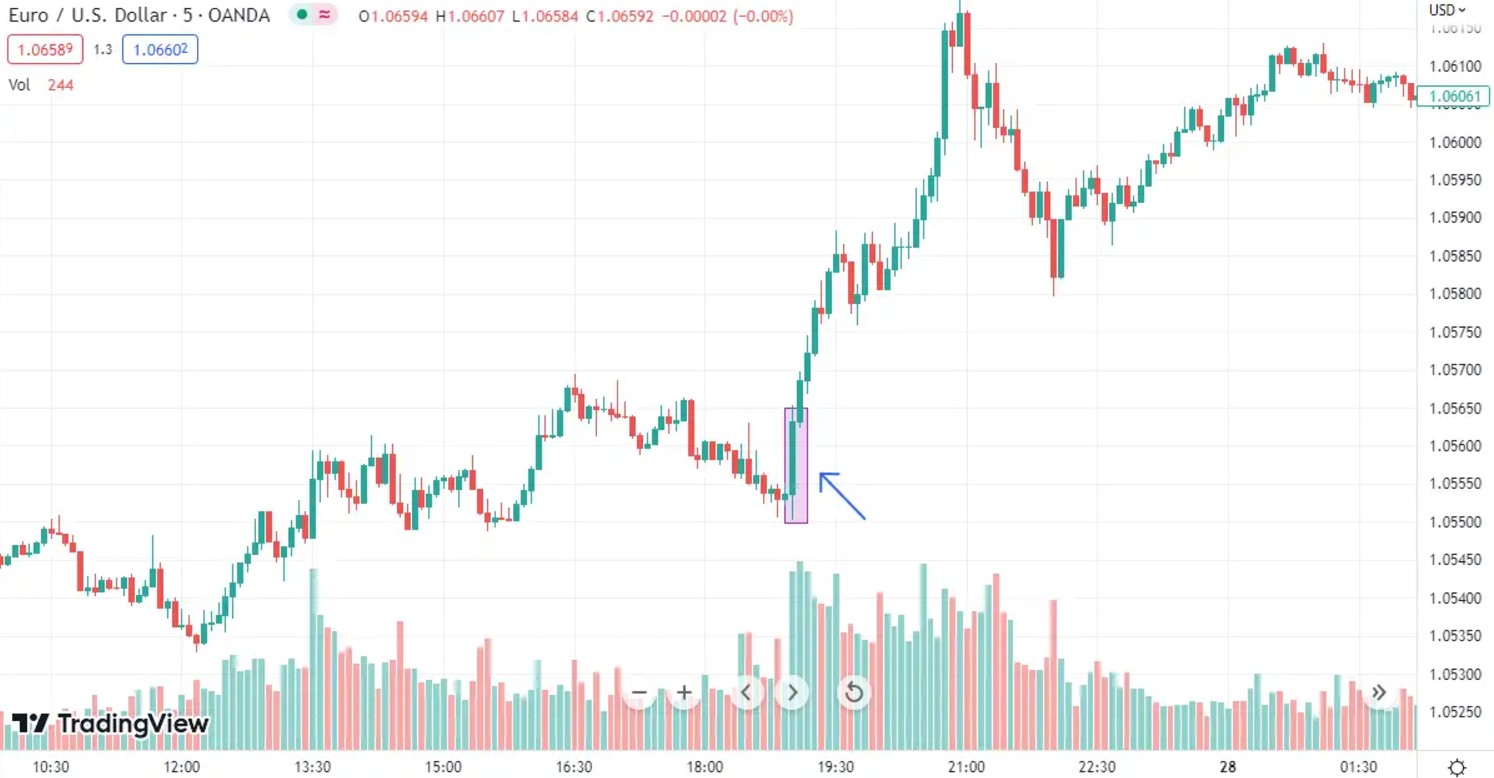
Breakout strategy
The Breakout strategy is heavily favored in the Forex market. It involves identifying key levels of support and resistance and entering trades when the price breaks through these levels. Traders typically use technical analysis tools, such as trend lines, chart patterns, and moving averages, to identify potential breakouts. The strategy can be applied to any currency pair and timeframe, making it suitable for both short-term and long-term trading.
One of the main benefits of the Breakout strategy is its potential for high profits. When a breakout occurs, the price can move sharply in the direction of the breakout, allowing traders to capture significant profits.

Chart pattern trading
Chart pattern trading is used in the Forex market and involves identifying patterns on price charts, such as head and shoulders, double tops and bottoms, and triangles, to determine potential trade opportunities. Traders using this strategy rely on technical analysis to identify patterns and then use them to make informed trading decisions. This strategy can be applied to any currency pair and timeframe, making it suitable for both short-term and long-term trading.
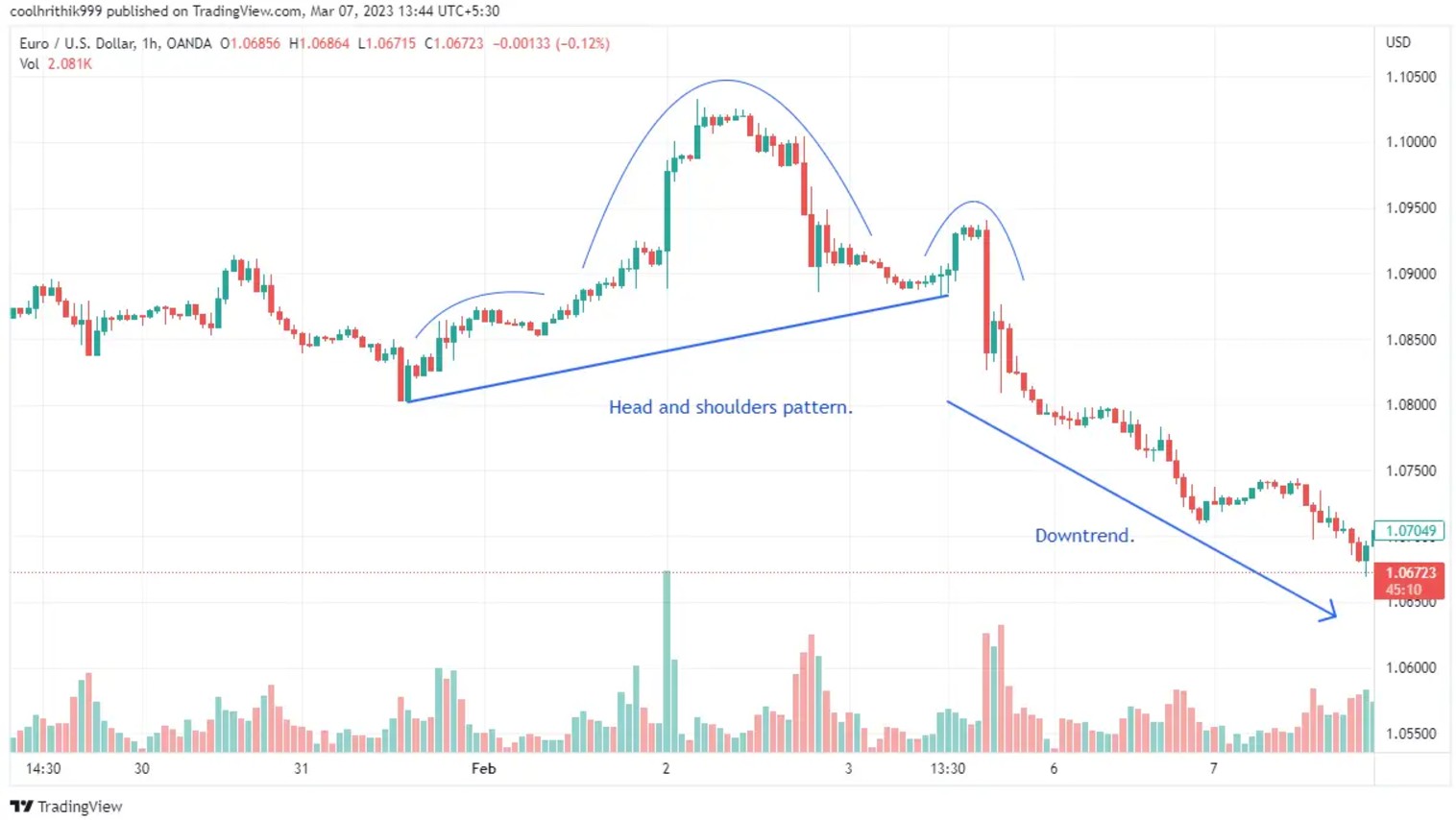
Trend following strategy
The trend-following strategy is used by Forex traders to identify and capitalize on long-term trends in the market. This strategy is based on the idea that markets trend and that traders can profit by following those trends. Trend-following traders typically use technical analysis to identify trends and use indicators such as moving averages, trendlines, and momentum indicators to confirm them. This strategy can be effective in any market condition, whether the market is trending up or down.

Fibonacci retracement trading
Forex traders use the Fibonacci retracement trading strategy to identify potential market support and resistance levels. This strategy is based on the Fibonacci sequence, a mathematical pattern that appears in nature and has been found to have applications in financial markets. The identified potential areas of support or resistance become levels where traders can enter or exit trades. This strategy can be effective in any market condition and can be used in combination with other technical analysis tools.
One of the main advantages of the Fibonacci retracement trading strategy is its ability to identify potential levels of support and resistance in the market. This can help traders enter or exit trades at strategic levels, which can improve their chances of success.
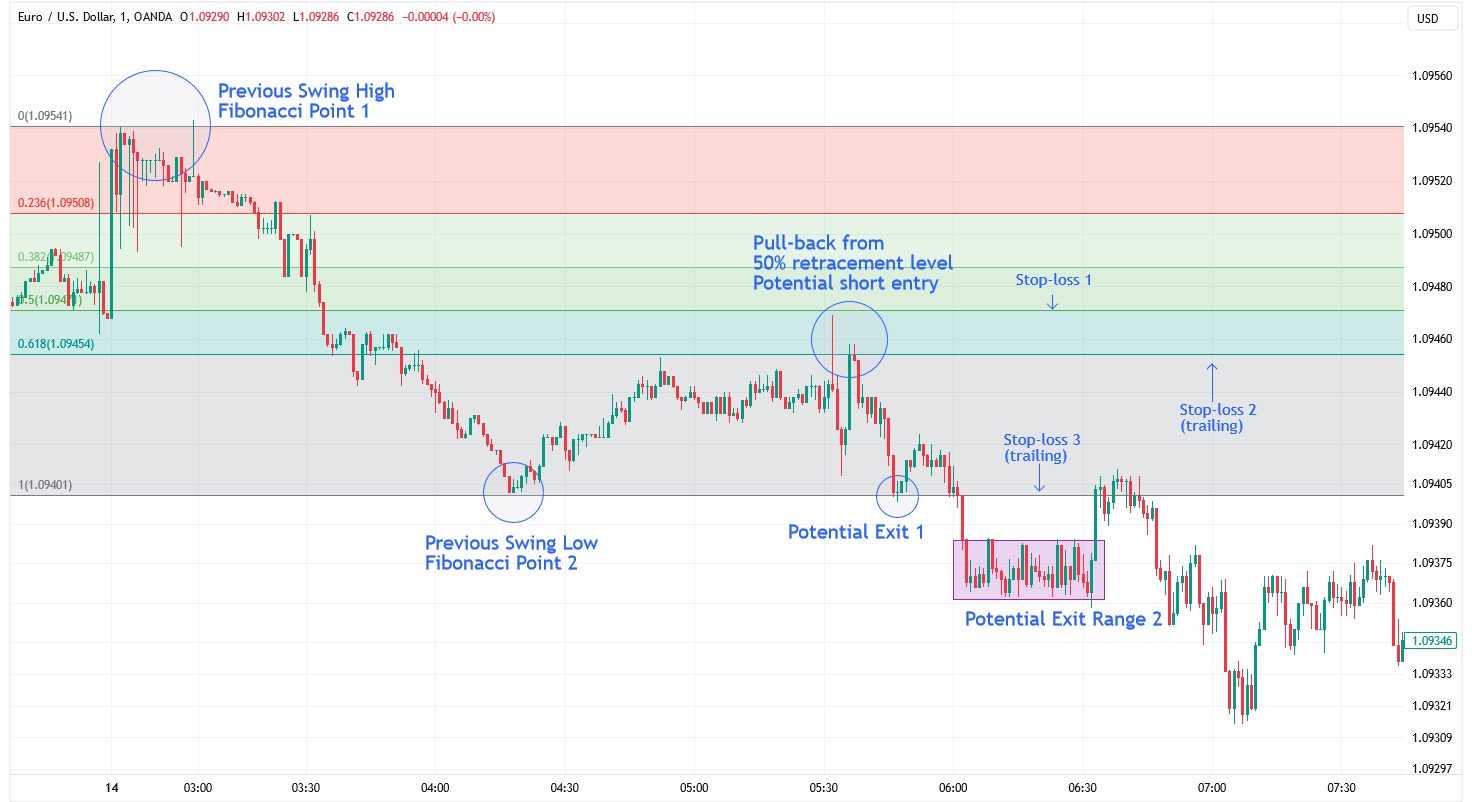
Scalping
Scalping is a Forex trading strategy that involves making multiple trades with the aim of making small profits from each trade. Traders who use this strategy hold positions for a very short period, typically between seconds and minutes, and aim to capitalize on small price movements in the market. This strategy requires a high level of focus and discipline, as traders must be able to make quick decisions and execute trades rapidly. Scalping can be effective in markets with high liquidity and volatility and can be used in combination with other technical analysis tools to confirm trade signals.
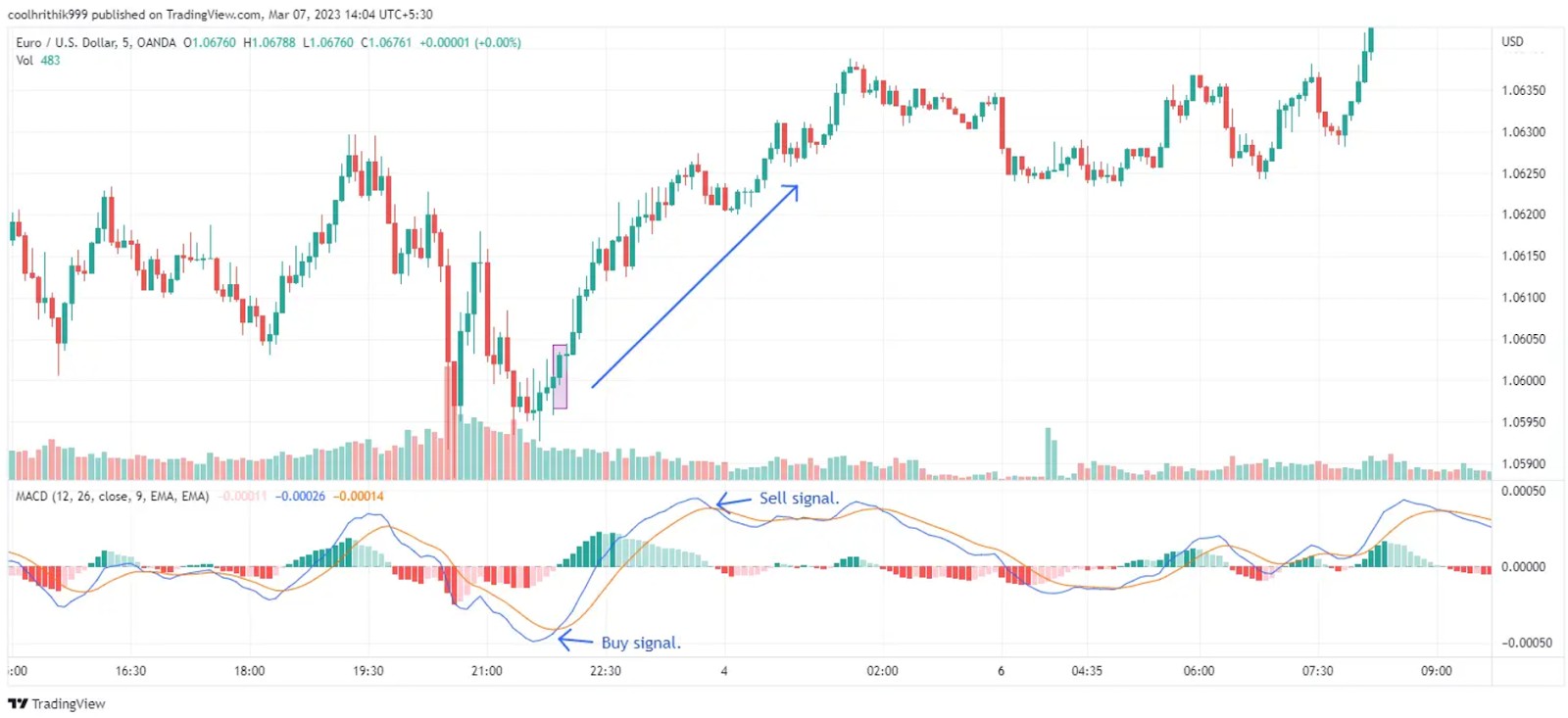
In the above illustration, we see a scalping trade with the help of MACD indicator. A trader would enter the trade at the MACD buy signal (price highlighted by the rectangular box) and exit at the MACD sell signal. Traders ideally use a time frame between 30 seconds to 15 minutes for this strategy, and a scalping trade can last for anywhere between seconds to minutes (based on the signal generated by the indicator being used.)
How to day trade in Forex?
Here is a step-by-step guide on how to day trade in Forex:
Choose your day trading strategy. The first step is to choose a day trading strategy that aligns with your goals and risk tolerance.
Choose a currency pair with good liquidity and volatility. It is important to choose a currency pair that is actively traded and has good volatility to ensure there is enough movement to generate profits. Popular currency pairs for day trading include EUR/USD, GBP/USD, and USD/JPY.
Choose a reliable broker. Make sure to choose a broker that aligns with your requirements and offers features specific to day trading, such as competitive spreads, high liquidity, fast execution, and advanced trading tools. We have shortlisted and compared the top options in the table below:
| Currency pairs | Demo | Min. deposit, $ | Min Spread EUR/USD, pips | Max Spread EUR/USD, pips | Scalping | Regulation level | Open an account | |
|---|---|---|---|---|---|---|---|---|
| 60 | Yes | 100 | 0,5 | 0,9 | Yes | Tier-1 | Open an account Your capital is at risk. |
|
| 90 | Yes | No | 0,5 | 1,5 | Yes | Tier-1 | Open an account Your capital is at risk.
|
|
| 68 | Yes | No | 0,1 | 0,5 | Yes | Tier-1 | Open an account Your capital is at risk. |
|
| 80 | Yes | 100 | 0,7 | 1,2 | Yes | Tier-1 | Study review | |
| 100 | Yes | No | 0,2 | 0,8 | Yes | Tier-1 | Open an account Your capital is at risk. |
Develop a trading plan. A plan for trading should consist of predetermined points for entering and exiting trades, stop-loss levels to minimize risk, and a specific amount of capital allocated for each trade.
Test your trading ideas. Before risking real money, it is important to test your trading ideas on day trading demo accounts to see how they perform in real market conditions.
Implement risk management techniques. To reduce potential losses, it is important to implement risk management techniques such as setting stop-loss orders and limiting the amount of capital you invest in each trade.
Monitor the market. Day trading requires constant monitoring of the market to identify potential opportunities and risks.
Stay disciplined. Day trading can be emotionally challenging, so it is important to stay disciplined and stick to your trading plan.
Focusing on when the market is most active can change the game
For beginners in Forex day trading, focusing on when the market is most active can change the game. Instead of trying to trade all day, zero in on the few hours when the London and New York sessions overlap. This is the busiest time, meaning prices move more, and you have better chances of catching solid trades. To take it a step further, watch what the big players are doing. Tools like order books or volume indicators can help you spot where institutions are making their moves, so you can follow their lead instead of guessing.
Another trick is to trade against the crowd after news releases. When big economic reports come out, prices often shoot up or down too far because everyone panics. This creates a chance to profit when things settle back down. Use tools like Bollinger Bands to see when the market’s gone too far, and wait for a reversal. Instead of chasing after the initial move, jump in when the market starts correcting itself. It’s a smarter way to trade during news events without getting caught up in the chaos.
Conclusion
Day trading in Forex is less about quick wins and more about steady, calculated moves. The most successful traders don’t just pick a strategy — they fine-tune it to match their style and understand how to react when markets get unpredictable. Whether you’re testing breakout patterns or scalping for small gains, what really matters is learning how to spot opportunities in real time and knowing when to step back. The goal isn’t just to win today but to keep growing your skills and confidence so you can trade smarter in any market environment.
FAQs
What is the best strategy for Forex day trading?
The best Forex day trading strategy is determined by a trader’s objectives, risk tolerance, and approach. Proven strategies like scalping, trend following, and breakout trading have consistently delivered results when executed with precision.
Is day trading in Forex profitable?
Forex day trading can be highly profitable but comes with significant risks. Achieving success requires a deep understanding of market dynamics, well-crafted strategies, and robust risk management techniques. Without these, profitability is unlikely.
Is there a minimum deposit to day trade Forex?
The minimum deposit for Forex day trading varies by broker and account type. While some brokers allow trading with no minimum deposit, others may require several hundred dollars or more. Choose a broker that aligns with your financial capacity and trading goals.
Can day trading Forex make you rich?
Forex day trading has the potential to generate substantial wealth, but it’s far from a get-rich-quick scheme. Success demands extensive knowledge, consistent practice, strict discipline, and effective risk management.
Related Articles
Team that worked on the article
Rahul Pritwani is a seasoned trader and passionate writer with a dynamic presence in the Stock Market. With an unwavering commitment to trading and the written word, he seamlessly blends financial expertise with articulate expression.
Chinmay Soni is a financial analyst with more than 5 years of experience in working with stocks, Forex, derivatives, and other assets. As a founder of a boutique research firm and an active researcher, he covers various industries and fields, providing insights backed by statistical data. He is also an educator in the field of finance and technology.
As an author for Traders Union, he contributes his deep analytical insights on various topics, taking into account various aspects.
Mirjan Hipolito is a journalist and news editor at Traders Union. She is an expert crypto writer with five years of experience in the financial markets. Her specialties are daily market news, price predictions, and Initial Coin Offerings (ICO).
Forex trading, short for foreign exchange trading, is the practice of buying and selling currencies in the global foreign exchange market with the aim of profiting from fluctuations in exchange rates. Traders speculate on whether one currency will rise or fall in value relative to another currency and make trading decisions accordingly. However, beware that trading carries risks, and you can lose your whole capital.
Volatility refers to the degree of variation or fluctuation in the price or value of a financial asset, such as stocks, bonds, or cryptocurrencies, over a period of time. Higher volatility indicates that an asset's price is experiencing more significant and rapid price swings, while lower volatility suggests relatively stable and gradual price movements.
Bollinger Bands (BBands) are a technical analysis tool that consists of three lines: a middle moving average and two outer bands that are typically set at a standard deviation away from the moving average. These bands help traders visualize potential price volatility and identify overbought or oversold conditions in the market.
Breakout trading is a trading strategy that focuses on identifying and profiting from significant price movements that occur when an asset's price breaches a well-defined level of support or resistance.
Index in trading is the measure of the performance of a group of stocks, which can include the assets and securities in it.






























































































































